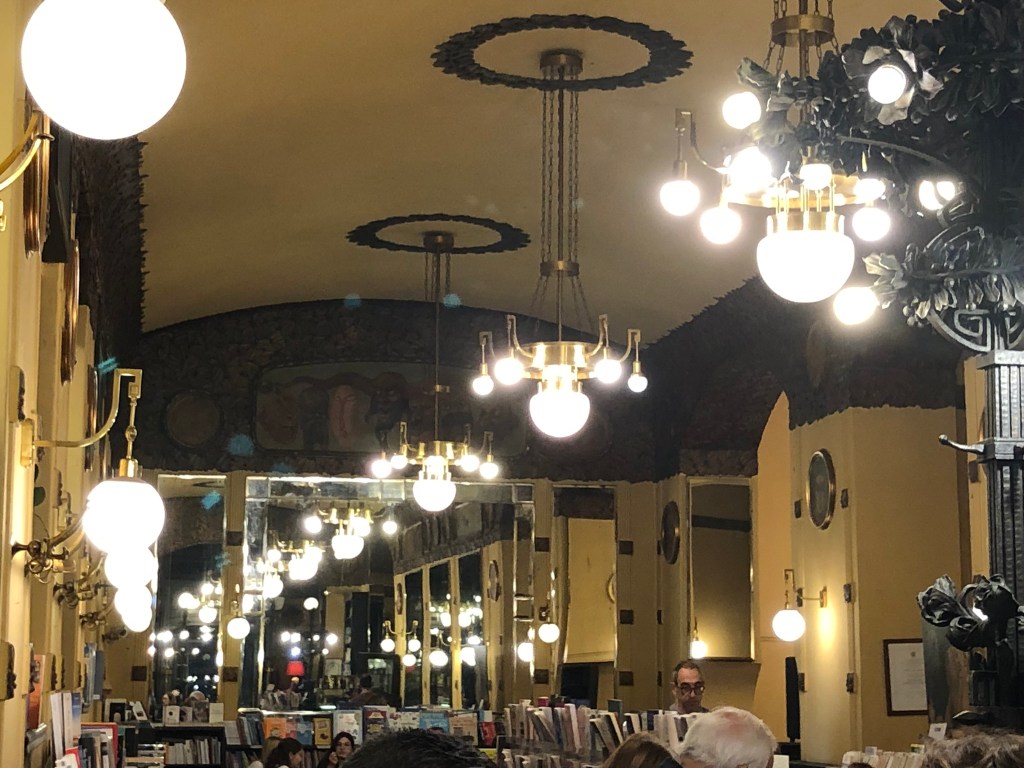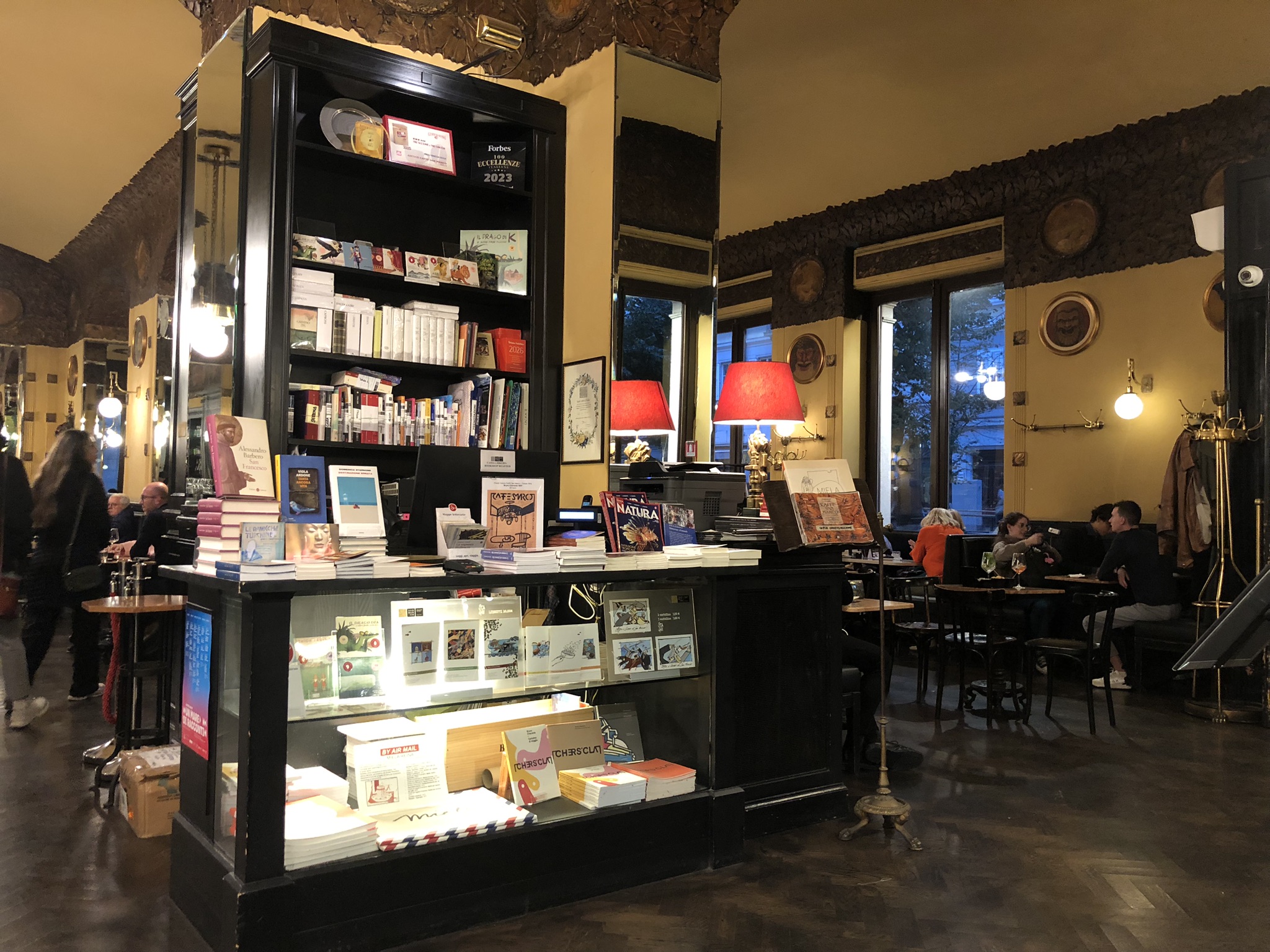It’s unlikely, for a number of good reasons, that after my death I shall end up in heaven. But if it happens, and if – an even more remote possibility – St Peter offers me a choice of where exactly in that fine place I’d like to be, I’d ask whether he could arrange for me to spend my eternal days in the paradisal equivalent of Caffè San Marco, in the Via Cesare Battisti, Trieste.

It’s a cafe that takes a bit of hunting out. It lies just beyond the concentration of hyper-grand Austro-Hungarian buildings in the city centre. You enter through a door bearing its name, and, in large characters on the metal door-plate, the date of its establishment, ‘1914’. A fateful year for the world, but especially for the rulers of Trieste, whose empire was about to come crashing down. After the War’s end Trieste would enter its long decline, after two centuries of enormous prosperity as the great and only seaport of the Habsburg emperors.

In front of you is the bar counter, full of bottles, coffee-makers, pasticcini and scurrying, uniformed staff. To the right are tables already fully occupied by customers: this is a cafe with many admirers. But it’s what lies in the corridor-like space to the left that’s so surprising – a medium-sized bookshop, with books ranged in several long rows for the coffee-drinkers to browse. Few covers are visible: this is a serious place, and it tries to pack in as many volumes as space will allow. The till lies near the bar counter, so that you can pay for your coffee and crossante and a new book almost in the same movement. Beyond the bookshop is another seating area. Customers there have no choice but to pass through the book space to reach the exit.

Caffè San Marco naturally attracted literary types. One of them was James Joyce, during his short second stay in Trieste in 1919-20, when he was busy writing the Nausicaa and Oxen of the Sun sections of Ulysses. Another was Italo Svevo, whose remarkable novel Zeno’s conscience Joyce, to his great credit, undertook to promote in Paris after it had flopped locally (as had Svevo’s earlier novels). A third was the melancholic Trieste poet, novelist and seller of antique books Umberto Saba.
Jan Morris, in her usual baroque but precise way, imagines the Caffè’s customers:
… the students with their text-books spread around them, the professors reading the day’s newspapers, the odd author sucking his pen meditatively over his novel, a scattering of ladies enjoying their daily coffee-talk and one or two flaky philosophers with spectacles sitting there hour after hour gazing at Time. If the empire still existed, an habitué once remarked to Claudio Magris (as recorded in his book Microcosms), ‘the world would still be a Cafè San Marco, and don’t you think that’s something, if you take a look out there?’
Though, Morris adds later, she may be mistaken in her interpretation: ‘those professors are probably company accountants really; the novelist is preparing a computer program and the sages are not contemplating Time, but waiting for the football on TV.’

It isn’t surprising that Trieste was a fertile place for writers. In Jan Morris’s phrase, it was a ‘nowhere’ place, where Italians mixed with Austrians, Croats and Slovenes at the furthest limit of western Europe. Cultures, languages, religions and customs collided and melded, under the distant and fairly tolerant direction of the Emperor and his apparatus. Though there was an Imperial Navy of sorts, it was based at Pola, now Pula, on the Istrian peninsula, and Trieste was mainly a commercial gateway, with railway connections to central Europe and maritime connections all over the Mediterranean and far beyond. In effect the city was run by the insurance and shipping companies whose enormous buildings faced the seafront and the Piazza Unità d’Italia, one of the largest public spaces in Italy.

We sit down opposite the bar, with a good view of the cafe staff and the bookshop, and the steady stream of coffee-seekers coming through the door. Our coffees, of course, are among the best we’ve tasted so far in Trieste, the coffee capital of Italy. We can’t tell who are the poets and novelists among our fellow-drinkers, but many of them are obviously regulars – we’re possibly the only tourists – and a good number stop to scan the bookshelves. Judging by the number and size of bookshops in its northern towns and cities, Italy still has a lively reading culture.

Caffè San Marco isn’t the only literary landmark in Trieste. Joyce flitted from home to home and bar to bar during his years in the city, and you can follow a James Joyce trail. On it you’ll come across Joyce himself, standing on a bridge across the Canal Grande – or rather a trim bronze statue of him, his shoulders and shoes worn to a smooth shine by the hundreds who’ve stopped to pass the time of day with him over the years. Saba has his own statue in Via Dante Alighieri, and his antiquarian bookshop is still open in Via S. Nicolò. And there’s a literary museum, Museo LETS, which we ran out of time to visit.
Our coffee’s long gone and it’s time for us to leave. We agree that, if by chance we found ourselves living in Trieste, Caffè San Marco would be our second home.

There’s no lack of other reasons to think that Trieste might make a congenial place to live: the grand Adriatic seafront with its long projecting pier, the Mole Audace, where we joined locals for a sunset passeggiata; Miramare, the mock castle along the bay built by Maximillian, archduke of Austria and the Emperor’s younger brother, before Napoleon III persuaded him to be installed as the Emperor of Mexico – where the restored republican government soon executed him by firing squad; the Linea 2 tram that climbs the steep limestone hill behind the city to the town of Opicina (for the steepest stretch the tram turns itself into a funicular railway). And, of course, there are many other fine cafés – Trieste has more coffee shops per head of population than anywhere in Italy – though none, I’d guess, than can quite match Caffè San Marco.


Leave a Reply to Vernon Cancel reply